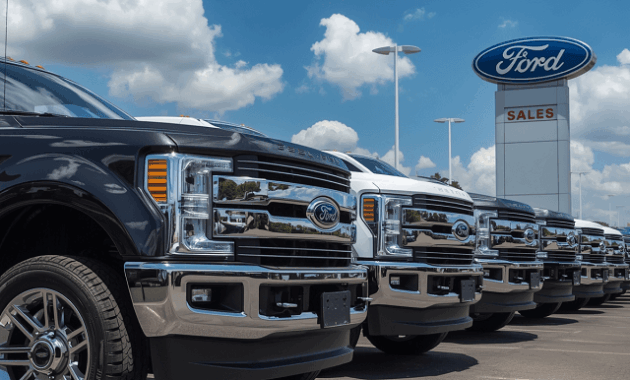Ford F-350 Super Duty Trucks for Sale: The Complete Buyer’s Guide The Ford F-350 Super Duty isn’t just another pickup—it’s a powerhouse built for the toughest jobs. Known for its incredible towing capacity, heavy payload rating, and unmatched durability, the F-350 stands as one of the most capable trucks on the market.
Whether you’re hauling a massive fifth-wheel RV, towing construction equipment to a job site, or simply need a truck that won’t back down from any challenge, the F-350 delivers. Shopping for a Ford F-350 Super Duty for sale means investing in strength, reliability, and long-term performance.
This ultimate guide will walk you through everything you need to know before buying—from engine choices to trims, towing capacity, pricing, and key buying tips.
Why the Ford F-350 Super Duty Stands Out
The “Super Duty” badge isn’t just for show. It represents a class of trucks designed specifically for severe-duty performance. Positioned above the F-150 and F-250, the F-350 is engineered with:
-
High-strength steel frame – fully boxed for maximum durability.
-
Heavy-duty components – including reinforced axles, suspension, and braking systems.
-
Powerful engine lineup – with both gasoline and diesel options to match your workload.
-
Smart towing technology – from trailer backup assist to advanced safety features.
This combination of raw muscle and smart engineering makes the F-350 a go-to choice for contractors, farmers, ranchers, and RV enthusiasts alike.
Buying Considerations for the Ford F-350
1. New vs. Used F-350
-
New Models – come with the latest tech, full warranty, and custom options, but higher upfront costs.
-
Used Models – offer better value, especially 2–5 years old, but require careful inspection for wear, maintenance history, and potential repairs.
2. Engine Options
-
7.3L “Godzilla” Gas V8 – lower cost, easier maintenance, strong low-end torque. Best if you don’t tow at max capacity all the time.
-
6.7L Power Stroke Diesel V8 – unmatched towing, better fuel economy under load, extreme torque. Best for heavy-duty haulers.
3. Cab Styles & Bed Lengths
-
Regular Cab – 2 doors, max payload, compact.
-
SuperCab – extended cab, occasional rear seating.
-
Crew Cab – 4 full doors, most comfortable, ideal for work and family.
-
Beds – 6.75 ft (versatile) or 8 ft (best for towing & max cargo).
4. Drivetrain Options
-
4×2 – better fuel economy, lighter, cheaper.
-
4×4 – essential for snow, mud, off-road, or heavy-duty use.
5. Trim Levels
From workhorse to luxury:
-
XL – pure utility.
-
XLT – adds comfort & convenience.
-
Lariat – leather, premium audio, advanced tech.
-
King Ranch – Western styling, premium finishes.
-
Platinum – luxury + advanced safety features.
-
Limited – fully loaded, flagship model.
6. Towing & Payload
-
Payload capacity varies based on cab, engine, and drivetrain.
-
Conventional towing vs. fifth-wheel/gooseneck towing—the F-350 excels at both, especially with the Power Stroke diesel.
Where to Buy an F-350 Super Duty
-
Ford Dealerships – best for new and Certified Pre-Owned (CPO).
-
Independent Dealerships – wider used selection, competitive pricing.
-
Online Marketplaces – CarGurus, AutoTrader, Cars.com, eBay Motors.
-
Private Sellers – best deals but require more due diligence.
-
Auctions – can be bargains, but trucks are sold as-is.
Ford F-350 Price Guide (Estimates)
| Trim Level | New MSRP (2024 est.) | Used (2020–2023) | Used (2017–2019) | Key Features |
|---|---|---|---|---|
| XL | $48K – $55K | $45K – $65K | $35K – $50K | Work truck, vinyl seats, basic tech |
| XLT | $53K – $65K | $50K – $70K | $40K – $55K | Cloth, power accessories, infotainment |
| Lariat | $67K – $80K | $60K – $85K | $48K – $68K | Leather, premium audio, advanced tech |
| King Ranch | $80K – $90K | $70K – $90K | $55K – $75K | Western styling, premium leather |
| Platinum | $85K – $95K | $75K – $95K | $60K – $80K | Luxury, safety tech, chrome details |
| Limited | $98K – $110K+ | $85K – $100K+ | $65K – $85K | Fully loaded, top-tier comfort |
FAQs About the Ford F-350 Super Duty
Q: What’s the difference between the F-250 and F-350?
A: The F-350 offers higher payload and towing ratings, thanks to reinforced suspension and axles.
Q: Should I buy gas or diesel?
A: Gas is cheaper upfront and easier to maintain. Diesel is best for heavy-duty towing and long hauls.
Q: Can I daily-drive an F-350?
A: Yes, especially Crew Cab versions. But expect challenges with parking and fuel economy.
Q: What’s the best year for a used F-350?
A: 2017+ models offer aluminum bodies, updated frames, and modern tech. Older models can be good value if well-maintained.
Q: How expensive is maintenance?
A: Gas models are cheaper. Diesel maintenance can run $1,000–$2,000 annually, but offers better longevity.
Final Thoughts
The Ford F-350 Super Duty is more than just a truck—it’s a tool engineered for those who demand maximum capability. From its rugged build and powerful engines to its advanced tech and comfortable cabins, it’s built to handle the heaviest loads and toughest jobs.
By considering your needs, budget, and the right configuration, you can find the perfect F-350 Super Duty for sale that will serve as a long-term partner on and off the road.
 Trucks for Sale Find the best deals on used trucks for sale across the USA. Browse pickups, semi trucks, dump trucks and more – updated daily
Trucks for Sale Find the best deals on used trucks for sale across the USA. Browse pickups, semi trucks, dump trucks and more – updated daily
